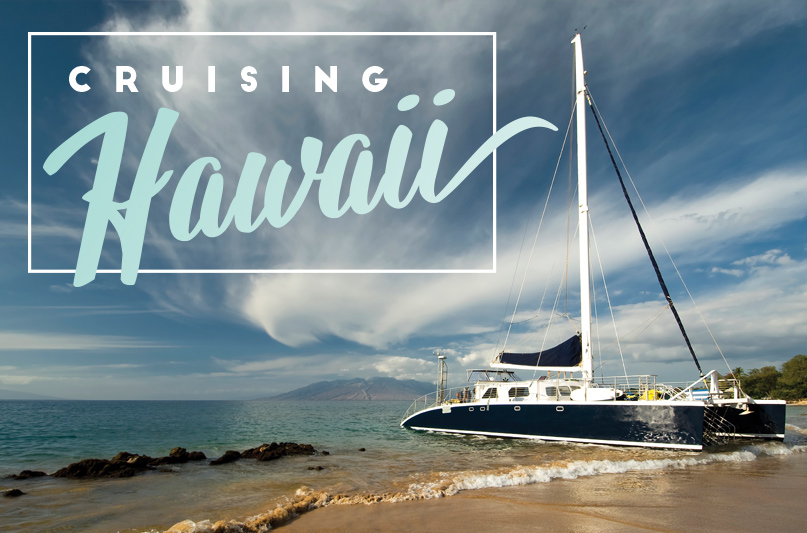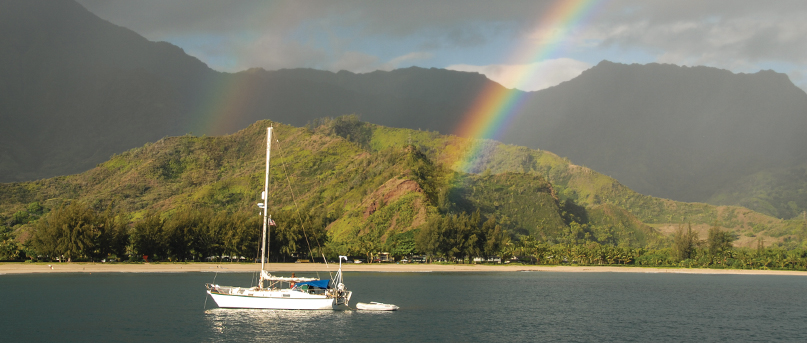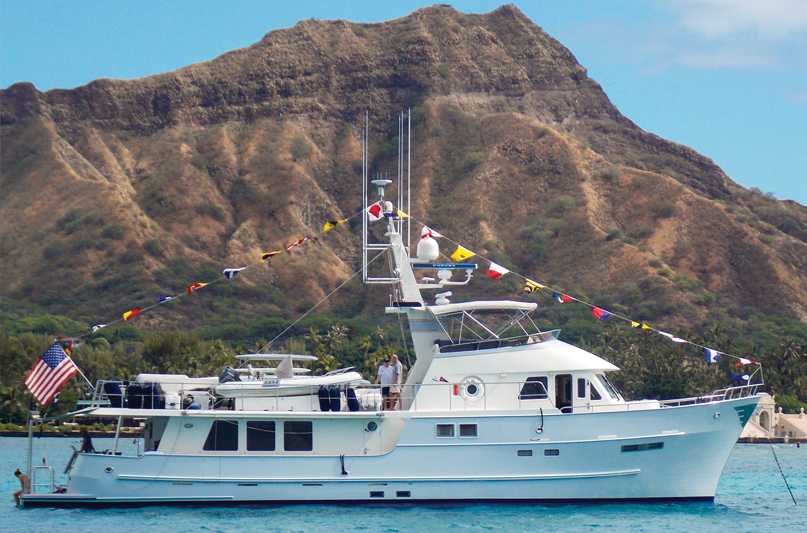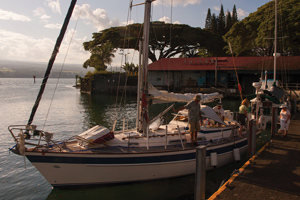
 I can almost smell the fragrant plumeria blossom leis I used to make from a tree in our yard where I grew up. I remember my childhood amazement at the humongous banyan trees, the delicate scrimshaw carvings, and seashells embedded in the roads. I laugh as I think of learning the Hukilau and swinging my skinny little hips staccato-style, attempting to mimic the exotic Tahitian-style dancing I witnessed at the Polynesian Cultural Center.
I can almost smell the fragrant plumeria blossom leis I used to make from a tree in our yard where I grew up. I remember my childhood amazement at the humongous banyan trees, the delicate scrimshaw carvings, and seashells embedded in the roads. I laugh as I think of learning the Hukilau and swinging my skinny little hips staccato-style, attempting to mimic the exotic Tahitian-style dancing I witnessed at the Polynesian Cultural Center.
The allure of the outer islands called, and my family bought a Cal-27 pop top when I was six, aptly named Ship of Fools; we had the boat before signing up for sailing lessons. The first lesson: never try to bridge a gap between two parting boats with my legs—which, as you might imagine, quickly turned into a fortunately warm but unscheduled swim. I have memories of struggling to paddle a dinghy in a straight line and windless days dragging on a line behind a boat moving almost imperceptibly yet feeling like my arm might be pulled from its socket. As our family developed sailing skills, we explored the islands by boat.
Our first forays across the channels between islands were exciting. I’ll never forget my annoyance at my parent’s rule on passage that we be either strapped in or down below, where we were overwhelmed by the smell of fuel that sloshed around in the rough waves. Nor will I forget my mother’s nervous reaction when I pointed out a rock that turned out to be a whale much larger than our boat. Undeterred, I thrived on the unique blend of Polynesian and Asian culture, lush tropical foliage, sandy beaches, turquoise and sapphire water, and the wonders of each island landfall.

Since my father lives in the Ala Wai Marina aboard his Valiant 47 Charisma, I know I can visit most anytime and explore by boat. The draw of sailing there on your own keel is understandable, and the Aloha dock offers a warm welcome to cruisers from around the globe — many I met while my father was Port Captain at the Hawaii Yacht Club (HYC). Yet, despite its charms, for a variety of reasons, cruising Hawaii can be challenging. If you check, you’ll note that bareboat charters are rare, a clue that sailing the islands is not well-suited to the novice sailor. Being prepared will make for a much happier cruising experience.
Sailing to Hawaii can offer a taste of pleasant offshore passage conditions before one commits to voyages farther afield; it lets ocean voyagers acclimate to bluewater sailing away from the sometimes intense conditions and myriad hazards along the continental shelf. Because Hawaii sits at the crossroads of the Pacific, it’s a natural stop on the way to Micronesia or the South Pacific or on the return from Mexico or Panama as many a Pacific Northwest cruiser can attest.
Don and Sharry Stabbert have made ten crossings of the Pacific and have been cruising back and forth to Hawaii since 2009 aboard Starr, their 77′ Steve Seaton trawler. Brian and Mary Alice O’Neill on Shibui, a Norseman 447, have cruised through Hawaii many times, most recently on their way to Micronesia and Japan and on their return from Mexico. Jessica and Tor Bjorklund stopped with their two boys on their homebuilt steel Tahiti Ketch Yare on a return from a multi-year foray into Mexico. Double circumnavigator Nancy Erley has traveled through the Hawaiian Islands on the way to and from Tahiti, from Panama, and made multiple round-trip visits.
Since sailors of all stripes convene from all directions, you’ll likely encounter those with information about places you might want to explore by boat. As a kid, meeting the world sailors who passed through sparked my desire for offshore adventures. My husband’s family sailed through Hawaii on their way to the South Pacific during their circumnavigation, learned about the Marquesas Islands while docked in Hawaii, and promptly revised their sailing plans to include a stop there. Swapping information and even charts about onward destinations is a rich nautical tradition.
The key determinant for the best sailing route to Hawaii is the location of the North Pacific High, a high-pressure area west of the North American continent. Typical sailing routes skirt this high, keeping it to starboard, to avoid getting caught in the no-wind zone at its center. Generally, the high has a clockwise rotation in the North Pacific, and you can ride it south until the winds start coming more from the east.
Experienced cruiser Stabbert says the best time to go from the Pacific Northwest is when you have a high pressure and the winds are out of the north. If you are leaving from any area below San Francisco you can stretch the window longer, but before December you may still be dodging tropical storms and hurricanes. Summer months are the best for extended cruising in Hawaii because anchorages that are exposed to northern swells, which include most of the best anchorages, are safest during this period. To get more time exploring the islands during settled summer trade winds, you might want leave in early summer. Regardless of when you go, you’ll want to watch the weather closely.
The Stabberts have found the PredictWind app to be the most reliable weather source and have used a professional weather router on their passages.

The Pacific Northwest has a three-hour time difference from Hawaii, so when sailing westwards, you’ll have to adjust to the new time zone. To avoid cheating crew out of an hour of sleep three times, some sailors change the clocks as soon as they leave the mainland and again just before arriving in Hawaii. On our passages, my husband Garth and I would split the hour and each take an extra half hour on watch to work through the transition at sea.
Prepare to spend some time perusing! How often do you board a yacht, much less many yachts, in a day? Be forewarned though, an all-outdoor show means that the weather is more of a factor than at indoor winter shows. Hours on the dock require protection from the sun, so be sure to bring sunscreen, hats, and glasses. If you plan to board any boats for a closer look, be respectful of the owners and wear deck shoes. Seattle tends to be nice in September, but the weather can go from cloudy to bright and back quickly, so consider dressing in layers and packing a small collapsible umbrella for the possible rain.
When making landfall, you have a choice of the following official ports of entry: Hilo on the Big Island; Kahului on Maui; Honolulu on Oahu; or Nawiliwili on Kauai. Because the direction of the prevailing wind (northeasterly) favors taking a northwesterly route through the archipelago, if you have your choice of arrival locations and plenty of time to explore, visit the ports in the listed order, starting with Hilo, unless you have significant repairs to make. If you do, head straight for Oahu, where the best repair facilities are available.
Jim and Barbara Cole made Hilo their first offshore stop on Complexity, their Hallberg Rassy 36, before sailing on to the South Pacific, Australia, and beyond. So did the Bjorklunds, coming from Mexico with their two sons. Check-in is easy and surprisingly relaxed, and the locals are friendly. Walking around Hilo is convenient for provisioning and minor repairs, though the sudden heat of the tropics sent the Coles to a military surplus shop in search of a boom tent for shade. Like many, they rented a car to visit Volcano National Park. The Bjorklunds also took advantage of the rental car to stock up at Costco on the Kona side. Like many, the Bjorklunds found Hilo convenient, as did we, Nancy Erley, and our friends Kim and Robert Milligan on the J/120 RAM on their way back from the South Pacific.
However, there is a drawback. Sailing on to the other islands across the Alenuihaha channel can be rough. Nancy Erley found the Alenuihaha Channel to be among the rougher patches of water she encountered during her circumnavigation. Stay north and consider crossing at night for a calmer passage.
One of the biggest challenges of cruising Hawaii is the strong winds and currents that funnel between the islands, which can make for boisterous channel crossings between them. The combination of wind, ocean swells, and currents can combine to create waves that are quite steep, and sailing across them can be wet and miserable.
Many prefer to make night passages between islands to take advantage of lighter winds. Making landfall in the darkness can be disorienting when trying to distinguish navigational lights from shore lights, so timing a passage to arrive during daylight may require estimating elapsed travel times and departing at odd hours.
The Alenuihaha Channel between Hawaii and Maui is 26 miles across, while the Pailolo Channel between Maui and Molokai is only eight miles. The Molokai Channel, which stretches between Molokai and Oahu is 23 miles. The largest gap lies between Oahu and Kauai.
If the idea of traversing across these rough channels sounds less than appealing or you are short on time, you might consider making landfall in Maui and confine your travel mileage within the cluster of islands of Maui, Lanai, Molokai, and Oahu. The downside of this approach would mean missing the relaxed atmosphere of Hilo and the sites of the big island and the lovely Hanalei Bay on Kauai.
The weather in Hawaii can change quickly and dramatically. Smart sailing means keeping a constant eye on the weather around you, knowing where safe harbors are on any given route, and being flexible. In all the islands there are only a few places in which you can anchor and be out of the swells.

Boaters need to be aware of local Kona winds and changing weather conditions in case you need to move. A place that is comfortable in trade wind conditions may not be comfortable in a southwesterly Kona wind condition. Venturing ashore, you’ll often need to land the dinghy between swells, leap out, grab the dinghy, and run up the beach before another wave arrives to swamp you. Getting the timing right is a skill my husband and I have had to perfect.
The Stabberts consider some sort of motion dampening equipment (like Flopper Stoppers) essential for comfort aboard in the many rolly anchorages, especially for motor boats. Last year, the Stabberts cruised 1,900 miles throughout the islands, were at anchor 90 days in various island anchorages, and 90 percent of the time they were the only power boat and often the only boat in an anchorage.
In some places there can be a scarcity of dock and anchorage space due to a prevalence of excursion boats and locals. An example of this is the tiny marina in Lahaina on Maui where med-moor-style dock space can be tough to attain. While Lahaina Yacht Club has eight mooring balls that are available for up to 14 days, it’s not a great anchorage if the wind comes up. Planning and calling ahead may make the difference between a pleasant and frustrating experience, but flexibility is key.
Before arriving in Oahu, you may be able to reserve space at Ko’Olina or in the Ala Wai, but chances are good that you will be able to find someplace at anchor or on buoys. The Stabbarts like the bight, just off Waikiki Beach, where there’s a niche in the coral reef at the foot of Diamond Head, or to tie up at the Waikiki Yacht Club, easy walking to shops and restaurants.
In Ala Wai, moorage is inexpensive and you can’t beat the heart of busy Waikiki. I especially love the Friday night races of the Hawaii Yacht club. The Bjorklunds found the Ala Wai an ideal place to provision and make repairs. They noted a few odd rules: if you stayed over seven days, you had to prove your boat was seaworthy; sign up for a utilities account if you wanted electricity; and add Ala Wai to your insurance policy.
The Bjorklunds found getting fuel was sometimes a challenge in the islands without hauling jerry cans, but there’s a nice fuel dock and pump out on Oahu at Ko’Olina, where many live aboard.
The two largest and calmest anchorages in the islands are Kanaohe, on the northeast side of Oahu, and Hanalei Bay on Kauai. Kaneohe is protected inside of a large reef, which means you’ll need to navigate carefully. It offers delightful aquamarine water with numerous places to anchor, mooring balls, and limited dock space, and the Kanoehe Yacht Club has a pool with a gorgeous view, clean showers, and outdoor dining. Hanalei Bay, my personal favorite and that of many others, is good in the summer when the trade winds are down. Both can be crowded with local boats depending on when you go.
While it would be impossible to do a full survey of anchorages in an article, many also favor an anchorage area called Ma’alaea Bay/Sugar Beach/Kihei, near Makenna State Park beach and Ma’alaea Harbor on the southwest side of Maui. It has a sandy bottom with great snorkeling nearby in the Five Caves area. Beach landings can be a challenge here and it’s exposed to Kona winds. On Molokini, a small crescent shaped extinct volcano vent about 3 miles off Maui’s southwest coast, you can secure a mooring ball (submerged when not in use) in the morning before cruise operators arrive and be rewarded with a great day of snorkeling.
One of my favorite anchorages is Poka’i Bay, within easy reach of Ko’Olina marina and Ala Wai on Oahu, which offers beautiful protected water for swimming and snorkeling.
Only a fraction of Hawaii’s best sites can be seen from the cockpit of a boat, so you may need to arrange for ground transportation to see them. Uber and Lyft are available in concentrated areas and buses are cheap. Renting a car to see sights farther afield may be necessary, like the Sea Cave on the road to Hana, Upcountry, and the Seven Sacred Pools in Maui.

Of the places they visited in the islands, the Bjorklund family loved seeing Haleakala at sunrise, a two-hour drive by rental car from Lahaina. In Hanalei Bay, they spotted their first green flash from the comfort of their cockpit.
As my dad likes to say with a shrug, “Just another day in Paradise.”
Read the full story on Issuu
